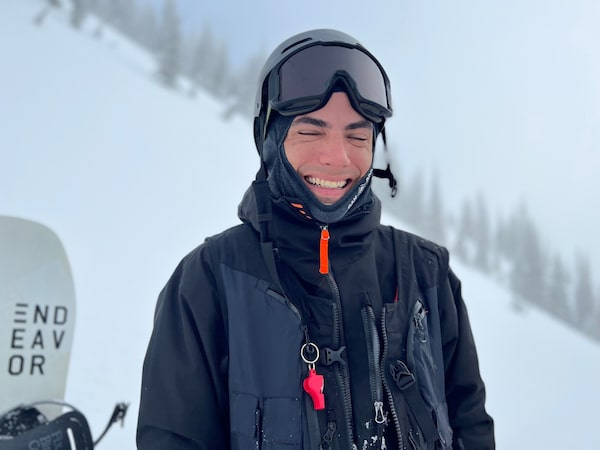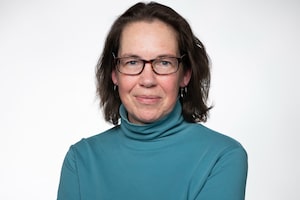
Sandy Ward (in the lead) and Myia Antoine head into their traditional lands in the backcountry of Whistler Blackcomb ski resort.Morgan Fleury/Handout
“If you’re not falling, you’re not learning.”
Sensible advice, especially if you’re learning to snowboard – where early days are spent mostly on your derriere. But it’s also a mantra taught to young members of the Indigenous Life Sport Academy.
“I absolutely love that quote,” Court Larabee, executive director and founder of ILSA, says. “It’s really about not being afraid to put yourself out there … It reverberates into all aspects of their lives outside of snowboarding.”
Last year, ILSA, which is run by Indigenous staff, helped more than 300 First Nations youth in the coastal communities of B.C.’s Sea-to-Sky Highway. Larabee says the youth are given a season’s pass, free equipment, clothing and lessons, including training to become a guide or instructor in their sport.
ILSA, which grew out of the First Nations Snowboard Team created in the lead up to the Vancouver Olympics, is expanding its program of free lessons, instruction and gear for Indigenous youth. This winter, youth in the Sinixt and Ktunaxa First Nations can shred the slopes at B.C.’s Fernie, Kimberley and Whitewater resorts and tear up the resorts’ mountain bike trails and skate parks in the summer. It’s part of a growing movement and a correction in the predominately white outdoors industry to get more Indigenous people to take part in outdoor sports and on resorts built on unceded and traditional territories.
Myia Antone, a member of the Squamish nation, is part of that movement. The 24-year-old created the non-profit Indigenous Women Outdoors in 2020, to teach outdoor skills and get more people like herself back onto the land. With corporate grants and support from the resorts and outdoor-gear companies, this year Antone says IWO is helping about 100 Indigenous women take part in ski, snowshoe and hiking days, including a smaller group taking intensive backcountry training.
IWO grew out of a hiking program Antone organized years earlier when she realized how being outside on her traditional land was important to her well-being and her community’s. “It allows me to take care of my spirit in a way that nothing else can.
“You are not just only healing yourself but you are healing your family line,” she says. “And, yeah, it’s fun to be out skiing and hiking and seeing how beautiful the lands are.”

Court Larabee, Indigenous relations specialist at Whistler Blackcomb ski resort and executive director and founder of Indigenous Life Sport Academy.Alicia Clark/Indigenous Life Sport Academy
The Squamish and Lil’wat nations share traditional territories that the 7,000 hectare Whistler Blackcomb ski resort now resides within. Recognition of this shared land and purpose meant that Vancouver’s 2010 Olympic bid was the first ever to include Indigenous groups in the process. And in December, 2021, four First Nations announced they are leading the charge for another winter games bid for 2030.
This shift in respect and direction is a welcome change, but Antone notes the success of the 2010 Games made Whistler busier than ever. With her land full of people year round, it’s harder to find space to hold traditional ceremonies, large and small. “Whistler was a big hunting ground for us and a very sacred place for ceremony, which we don’t get to do any more,” she says, adding it’s even hard for her to bathe in the river every morning as part of her own sacred ritual. “There’s always people around. I have to go in the dark.”
Getting more Indigenous out, instead of just the tourists, to enjoy their land is one of Antone’s goals but she also hopes the new skills get her clients thinking about a career, too. Last year, IWO helped seven Indigenous women become certified to teach Level 1 mountain biking.
It can be a long haul to become certified guide or instructor in your sport – classes for entry level instructors can be done in a few days but cost up to $600. Certification to become a ski or mountain guide, however, requires dozens of courses over several years and many thousands of dollars. Pretty high barriers for those without the money or connections to get started.
Sandy Ward, a member of Lil’wat Nation, got lucky. Ward taught herself to snowboard at 15, then joined the First Nations Snowboard Team in its first year and trained and competed in halfpipe and snowboard cross. FNST also paid for her training to become an instructor at Whistler Blackcomb, which came in handy when she stopped competing. Ward has turned her passion for snowboarding into a 17-year (and counting) career.

Sandy Ward takes a selfie with a group. Ward has turned her passion for snowboarding into a 17-year (and counting) career.Sandy Ward/Handout
For years, though, she felt like she was the only Indigenous woman on a snowboard. “I was always known as ‘the snowboarder’ in my [Lil’wat] community. I started to realize I don’t want to be known as ‘the snowboarder,’ there’s room for way more than just me out there.”
The training clinics and social ski days she runs with ILSA and IWO are changing that. Both organizations are important to Ward, though she particularly enjoys reinforcing the matriarchy. “Indigenous women have been oppressed,” she says. “[They] were always leaders before and getting back to those roles through outdoor recreation is a start.”
While she trains and encourages the next generation, she’s also teaching her tourist clients and non-Indigenous instructors at Whistler Blackcomb about Lil’wat uses of the land and traditional names. Mount Currie, she’ll point out, is called Ts’zil in the Lillooet language. “Our names for places are so deep and rich, and I often go into a story of why it got that name. It connects everybody better to the place that they are in,” Ward says. “I want to instill … those traditional place names and not have it feel weird to be saying our words instead.”
Winterized motorhome turns family vacation to Banff into ski adventure
Ward taught Jill Dunnigan, who runs the ski guide service Extremely Canadian, the Indigenous story behind one of her favourite runs.
“When I ski down ‘Trapline’ now I think how cool that it was someone’s trapline,” Dunnigan says. “But I’m also sorry that this traditional land became crown land that was leased to Blackcomb mountain, which is a private corporation. Would the Wallace’s still be trapping if that didn’t happen?”
Learning more about the resort’s traditional lands will be easier in the alpine this summer when the snow melts off nine new plaques installed on Whistler peak – several note locations of traditional Lil’wat and Squamish villages and the names of the surrounding mountains in both languages. Squamish artist James Harry was commissioned to design the art that appears on each sign.

Hallie and Hayden Sampson, of the Lilwat Nation, take part in an ILSA lesson and learn to snowboard on Blackcomb Mountain.Christie Fitzpatrick/WhistlerBlackcomb
The plaques are part of Larabee’s other job – as Whistler Blackcomb’s Indigenous relations specialist, where he says he works to “Indigenize the [resort] experience in an authentic way.” That’s everything from helping to negotiate land and title rights with Lil’wat and Squamish Nations when the resort needs to build new trails to hiring more Indigenous contractors and employees and “cultural competency” training for staff and senior executives.
He also wants to make Squamish and Lil’wat languages and art more visible. Staff buildings once named for glaciers and ski runs are now known by Indigenous pictographs and important cultural animals: Thunderbird, Wolf, Moose, Grizzley and Salmon. Renaming trail runs, however, isn’t so easy.
“It is critical the changes we make are both culturally accurate and a genuine reflection of our relationship,” writes Tom Dukeson, the resort’s communications manager, in an e-mail. “In this case, the trails are something this business has built into the land, so they really reflect the Whistler Blackcomb trail builders’, founders’ and guests’ traditions and vision.”
Larabee is happy to be part of the changes. A member of Lac des Mille Lacs First Nation near Thunder Bay, Ont., he moved to Whistler 15 years ago to snowboard and heal his spirit. He’s a fourth-generation residential school survivor and he was taken from his family during the Sixties Scoop. As he grew up, he found that a day on the ski hill helped him forget he was different: He could blend in behind his goggles, gloves and gear. When he got to Whistler he began volunteering as a coach for the FNST. It was a dream job and he never left.
He knows that organizations such ILSA, IWO and Spirit North, which teaches sports to Indigenous youth in communities from Alberta to Northern Ontario, are making a difference. For one thing, Indigenous kids aren’t going to have to hide behind their winter gear to thrive on the mountain.
“We are trying to fill every part of the ski and snowboarding and biking and climbing industries with beautiful Indigenous faces,” he says.
How can visitors be more respectful?
Learn about the Indigenous areas you are exploring by making time to visit the cultural and welcome centres you find. In Whistler, the Squamish Lil’wat Cultural Centre (SLCC) is a good place to start. Travellers should try to learn a few words in the local Indigenous language, suggest Antone and Larabee. Even better, look up the traditional names of the mountains you are travelling on. And work with Indigenous tour guides, shops and hotels. slcc.ca
Before heading into the mountains, book into Vancouver’s Skwachàys Lodge, an Indigenous-owned boutique hotel that supports artists. Guests who stay in the 18 rooms on the top two floors, all decorated in First Nations art, and who make purchases in the excellent lobby gift shop, support the artists housed elsewhere in the building. Skwachàys Lodge has a rooftop gathering space and free breakfast in its comfy common room. The hotel is steps from Chinatown, Gastown and on the edge of the Downtown Eastside. 31 West Pender St., skwachays.com.
Also in Vancouver, Salmon ‘n’ Bannock is an Indigenous-owned and operated fine-dining restaurant. The restaurant is intimate and atmospheric – even pandemic plexiglass dividers between tables are carved with art – and the menu offers elevated comfort foods: bison pot roast, bannock tacos, salmon burgers and pemmican mousse with bannock crackers – to name a few. 1128 West Broadway, salmonandbannock.net
Keep up to date with the weekly Sightseer newsletter. Sign up today.
 Catherine Dawson March
Catherine Dawson March